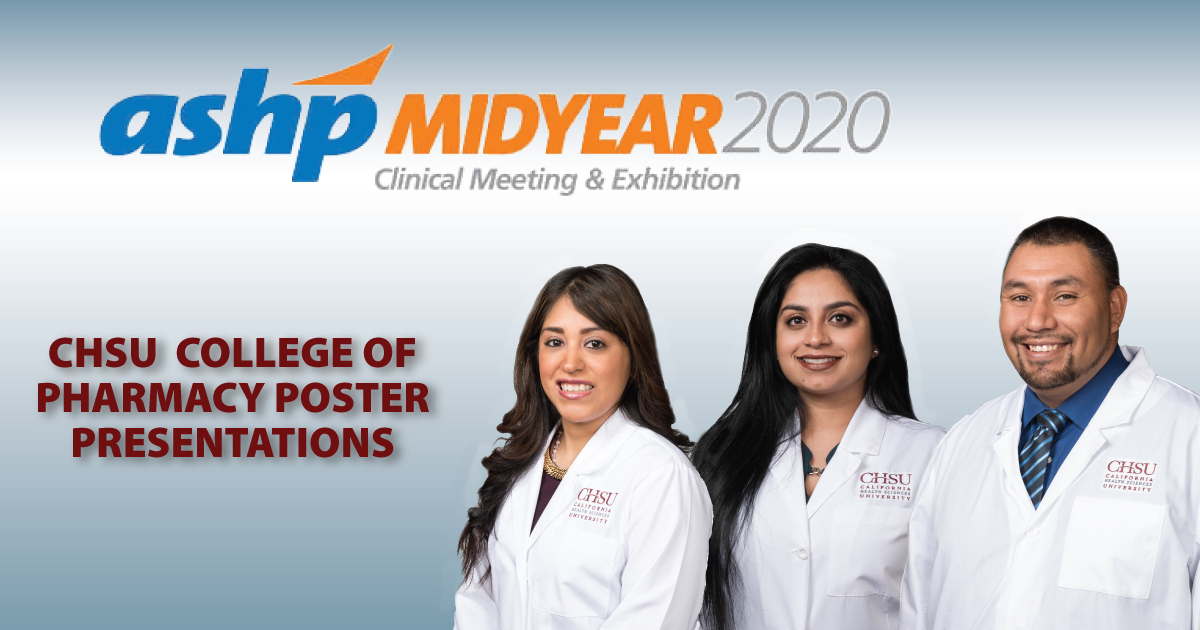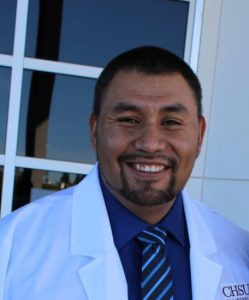CHSU Pharmacy Students Present at ASHP Midyear Virtual Conference
December 22, 2020

Congratulations to California Health Sciences University College of Pharmacy 4th year students Raymond Alcaraz, Karen Cruz Pelham, and Manpreet “Monica” Kaur, who presented at the 2020 ASHP Midyear Virtual Conference!
Every year, the ASHP Midyear Clinical Meeting and Exhibition provides health-system pharmacy practitioners with an outlet for updating their knowledge, networking with colleagues, enhancing their skills, and learning about the latest products and technologies. With its focus on improving patient care, the Midyear brings together over 20,000 pharmacy professionals from 86 countries, making it the largest meeting of pharmacists in the world.
Raymond, Karen and Monica represented CHSU College of Pharmacy by presenting their research on the following topics.
Raymond Alcaraz
“Activation of angiotensin type 2 (AT2) receptor ameliorates alveolar epithelial cell injury in vitro”

Raymond Alcaraz presented an evaluative study on an investigational drug called compound 21 that was co-authored by Vinayak Shenoy, MPharm, PhD, Assistant Professor of Pharmacology at CHSU College of Pharmacy. This study investigated the effects of C21 against bleomycin-induced death of human pulmonary alveolar epithelial cells (A549).
He chose this topic because of the work he has done in the CHSU lab with Dr. Vinayak Shenoy on the subject that began two years ago. Pulmonary fibrosis is a life-threatening disease with a typical survival rate of 3 years. His findings indicated that selective activation of the AT2 receptor ameliorates bleomycin-induced alveolar epithelial cell death in vitro. Which means compound 21 shows promise of an increase in cell survival in vitro as well as an increased level of the AT2 receptor.
Living in the Central Valley, people suffer from many different respiratory problems,” said Raymond. “It was an honor and a privilege to investigate a drug that works on alveolar cells, and perhaps someday make a difference in treating respiratory illnesses.”
Karen Cruz Pelham
“Cisplatin and Renal Dysfunction; Where electrolytes begin and forced diuresis ends”

Karen Cruz Pelham presented an extensive literature review that examined 13 clinical trials and studies with a focus on hydration regimens to prevent nephrotoxicity caused by cisplatin treated patients that was co-authored by Maya Leiva, PharmD, Assistant Professor of Clinical Sciences at CHSU College of Pharmacy.
Cisplatin is a platinum-based drug that is used to treat various types of solid tumors such as head, neck, lung, and genitourinary tract tumors. Based on the research conducted, their recommendation is to supplement the patient with electrolytes pre- and post-hydration for all patients receiving cisplatin. Their future aim is to perform a prospective study in patients receiving varying doses of cisplatin and hydration protocols to determine the most effective method for preventing cisplatin related nephrotoxicity.
“One of my interests is the topic of oncology and it stems from losing both parents to different types of cancer,” said Karen. “I was able to co-author this original project and it was a great opportunity to learn about the abstract and presentation process.”
Manpreet “Monica” Kaur
“Analysis of clinical trials targeting the Wnt signaling pathway for cancer therapy”

Manpreet “Monica” Kaur presented an evaluative study on a thorough analysis of various clinical trials associated with the use of Wnt-targeted drugs in the field of cancer therapy that was co-authored by Ann Neiheisel, P4 student and Anitha Shenoy, MS, PhD, Assistant Professor of Pharmacology at CHSU College of Pharmacy.
According to the American Cancer Society, in 2020, there will approximately be 150,580 new cancer cases and 50,540 cancer deaths every month. It is apparent that drugs that target aberrant pathways in cancer is a necessity. But the Wnt signaling pathway is dysregulated in several types of cancers, and are highly associated in various cancers, making it a potential target for cancer therapy. Although there have been numerous clinical trials over the past two decades, none of the Wnt pathway modifiers are in oncology practice yet. In the study, they performed a thorough analysis of various clinical trials associated with the use of Wnt-targeted drugs in the field of cancer therapy.
“It all started when Ann Neiheisel and I decided to enroll in Dr. Anitha Shenoy’s independent elective,” said Monica. “Little did we know, on our mission to learn how to culture breast cancer cells, create primers and amplify with PCR, our suspicions would lead us on a quest to find answers to a new question altogether – why none of the Wnt pathway modifiers are used in oncology practice yet.”